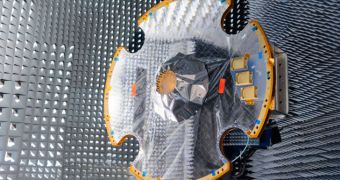This impressive image shows the antenna that will enable the European Space Agency's (ESA) Gaia spacecraft to survey more than a billion stars, after it launches to space in 2013. The vehicle will conduct its extremely sensitive measurements from the L2 Lagrangian point.
This is a location some 1.5 million kilometers away from Earth, where the spacecraft will remain in the same relative position in respect to the Earth-Moon-Sun system. Starting 2018, it will be joined there by the NASA James Webb Space Telescope (JWST).
The purpose of Gaia is to create a 3D map of stars in the Milky Way. For this purpose, it will relay back more than 200 TB of data over the course of 5 years. That is the equivalent of 45,000 DVDs. Its antenna is what enables it to perform such a complex study.
The 1.5-meter instrument was recently put through its paces in a special test chamber at EADS CASA, in Madrid, Spain. Unlike conventional mechanical antennas, this one uses complex technology to seamlessly maintain its orientation towards Earth as the spacecraft rotates through space.

 14 DAY TRIAL //
14 DAY TRIAL //